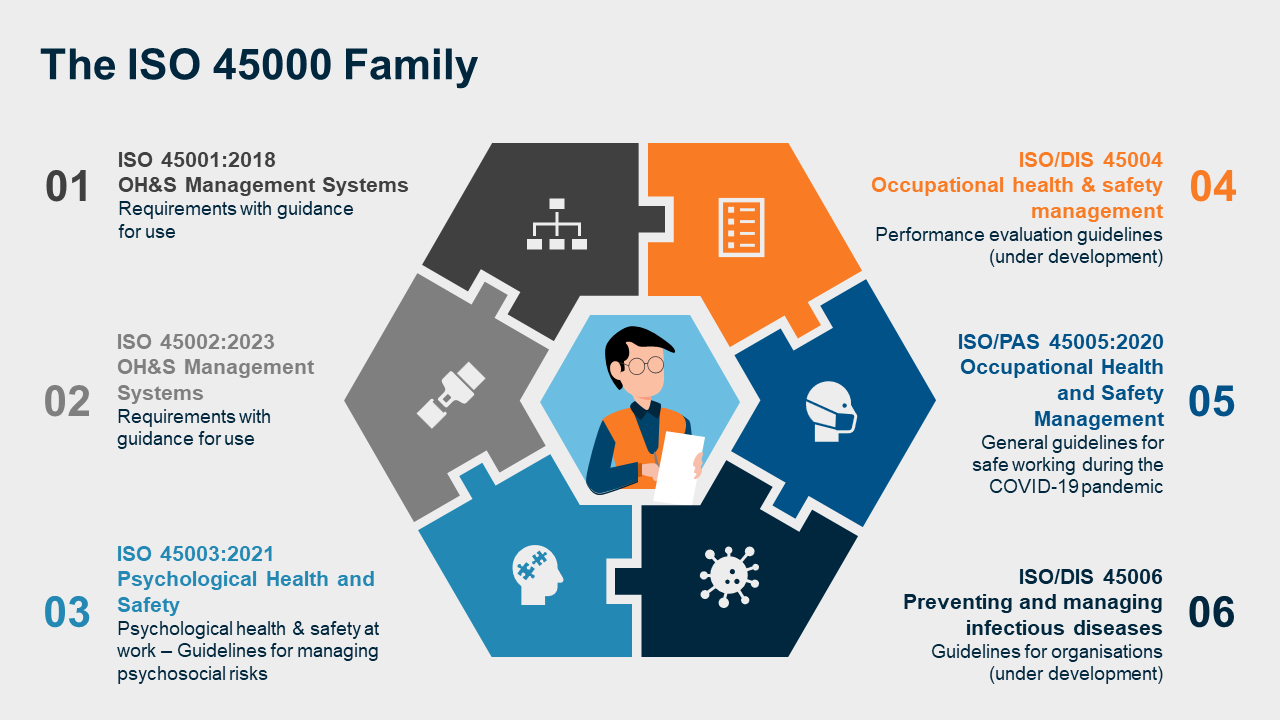World Day for Safety and Health at Work is held annually on 28 April. The day aims to raise global awareness of how to make workplaces safe and healthy for everyone. This year’s theme, set by the International Labour Organisation (ILO), is “a safe and healthy environment is a fundamental principle and right at work”[1]https://www.ilo.org/global/topics/safety-and-health-at-work/events-training/events-meetings/safeday2023/lang–en/index.htm.
Standards have a great role to play in helping organisations to build safe systems of work that can not only help an organisation to demonstrate its fulfilment of compliance obligations relating to WHS/OH&S, but more importantly, provide for a safe and healthy workplace for workers. The first global standard for OH&S, ISO 45001:2018, provides the framework to systematically manage OH&S risks, improve safety performance, and enhance well-being at work. Almost 300,000 organisations in over 170 countries were certified to ISO 45001 in 2021[2]https://www.iso.org/the-iso-survey.html.
ISO 45001 is part of the ISO 45000 family of standards and guidelines, which were developed to help organisations address the increasing need to manage OH&S risks in a systematic and effective manner. The standards provide a structured approach to managing risk, ensuring that organisations identify and control the hazards and risks associated with their activities and provide a safe and healthy workplace for their employees and other stakeholders. They provide a framework for managing OH&S risks in the workplace and help an organisation build a robust OH&S approach.
The family of standards includes ISO 45001 and other related standards such as ISO 45002, which provides guidelines for managing OH&S risks, and ISO 45003 which provides guidelines for managing psychosocial risks in the workplace. Here we outline each member of the ISO 45000 family in further detail:

ISO 45001
ISO 45001 was published in March 2018 and is designed to help organisations of all sizes and industries create safer and healthier workplaces. It is the flagship standard of the family and provides a framework for establishing, implementing, maintaining and improving an OH&S management system to manage the health and safety risks associated with an organisation’s activities, products, and services. It emphasises the importance of continual improvement and engagement with workers, as well as the need for effective communication and collaboration throughout the organisation.
ISO 45001 replaced the previously used OHSAS 18001:2007 and AS/NZS 4801:2001 standards, and it aligns with other ISO management system standards, such as ISO 9001 and ISO 14001. The adoption of ISO 45001 helps organisations demonstrate their commitment to workplace health and safety and can help to improve an organisation’s overall performance and reputation.
Whilst many organisations that implement an OH&S management system aligned with ISO 45001 do so with the aim to become certified by an independent conformity assessment body, this may not be the end foal for all organisations; some may wish to align with or implement the standard without becoming certified as the structure and requirements of the standard provide for a systematic approach to OH&S management without mandating certification.
ISO 45002
ISO 45002 describes the intent of each clause of ISO 45001. It gives guidance on the establishment, implementation, maintenance, and continual improvement of an OH&S management system that conforms to ISO 45001. While ISO 45001 outlines what to do, this document gives guidance and examples on how to do it. Unlike ISO 45001, ISO 45002 is not a certifiable standard – it exists primarily to provide guidance to organisations seeking to implement ISO 45001.
Published in February 2023, the standard includes real life examples of how different types of organisations have implemented the requirements of ISO 45001. These examples are not intended to suggest the best or only way to do this, but describes a way an organisation has used the standard to improve the effectiveness of their management system and overall OH&S performance.
The standard can be used by many different types of organisations of all sizes at various stages of their ISO 45001 management systems journey. The additional guidance helps ensure specific needs of diverse groups or individuals can be addressed by the OH&S management system. It also can be applied by those organisations who wish to implement processes for managing other risks – for instance, psychosocial risk, like those outlined in ISO 45003.
ISO 45003
ISO 45003 provides guidelines for managing psychosocial risk within an OH&S management system based on ISO 45001. The standard was published in 2020 and focuses on the prevention and management of psychosocial risks.
It’s the world’s first international standard to recognise that employers have a responsibility to protect the psychosocial health of their people. The standard provides guidance on managing psychological health in the workplace, defines psychosocial hazards, and provides a structured framework to develop, implement, maintain, and continually improve mental health and psychological safety in the workplace. The standard includes specific guidelines for managing work-related stress, bullying and harassment, workplace violence and other psychosocial factors.
It is applicable to all organisations regardless of size and aims to ensure they create an environment conducive to the physical and mental safety of employees wherever work is being carried out.
By implementing ISO 45003, organisations can improve the mental health and well being of their employees, reduce absenteeism and turnover, and increase productivity and profitability. It can also help organisations to comply legal and regulatory requirements related to OH&S
ISO/DIS 45004
ISO/DIS 45004 is currently under development and will provide guidelines on how organisations can monitor, measure, analyse, and evaluate OH&S performance and to select performance evaluation indicators that will support continual OH&S improvement. It is expected that there will be guidance on how performance evaluation processes should be designed and developed, how they can be improved, areas to avoid and how to include the performance evaluation process as part of usual business processes.
ISO/PAS 45005
ISO/PAS 45005 is a set of guidelines designed to help organisations manage work-related health and safety risks during the COVID-19 pandemic. This standard was published by ISO in November 2020 and provides practical tools and guidance for organisations to manage the risks associated with COVID-19. It is applicable to organisations who operated throughout the pandemic, are resuming or planning to resume operations, are reoccupying their workspaces, and new businesses.
The standard provides guidance on the protection of workers – employees, contractors, self-employed, agency workers, older workers, workers with disabilities, and first responders – and other interested parties – including visitors to the workplace and members of the public. In addition, the standard also outlines risk management in the office, home, or other work environments.
ISO 45005 includes detailed information on how organisations can identify, assess, and manage workplace risks related to the COVID-19 pandemic, as well as how to develop effective plans and strategies to limit the spread of the virus in the workplace. It also includes guidance on implementing proper safety protocols, providing training and education to employees, and monitoring and reviewing the effectiveness of safety measures.
ISO/DIS 45006
ISO/DIS 45006 is based on ISO 45005 but is applicable to all infectious diseases. Still under development, it is a response to risks related to infectious disease hazards in all workplace settings, including at home. The standard covers how to prevent exposure to infectious diseases that could present a risk to the health and safety of workers and significantly impact an organisation’s ability to operate.
By implementing the guidelines in ISO 45006, organisations should be able to take effective action to protect workers and other stakeholders from the risks related to infectious diseases. They are able to demonstrate they are addressing risks using a systematic approach and have evidence that they have established a framework to enable organisations to adapt to changing conditions in an effective and timely manner.
Data from Safework Australia shows that in 2021, there were 169 work-related fatalities in Australia and over 130,000 worker’s compensation claims of a serious nature (absence from work for one working week or more)[3]https://www.safeworkaustralia.gov.au/sites/default/files/2023-01/key_whs_stats_2022_17jan2023.pdf. This shows that, for some organisations, there is some work to be done in making their workplaces healthy and safe for their people.
Organisations are responsible for the health and safety of their workers, contractors, and customers, including promoting and protecting their physical and mental health. Aligning OH&S processes to a standard such as ISO 45001 enables organisations to respond to regulatory compliance issues, reduce the cost of incidents and operational downtime, and improve employee workplace satisfaction. It shows an organisation’s commitment to the health, safety, and wellbeing of its workers. This can help to build a positive reputation for the business, helping to ensure its success and longevity.
For information on the RTP’s OH&S Management Systems courses, click here or call us on 1300 95 96 92.


